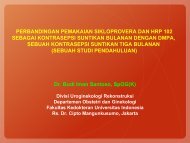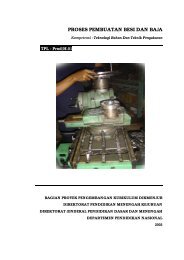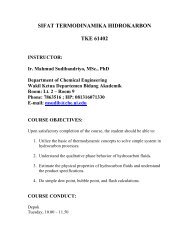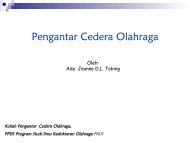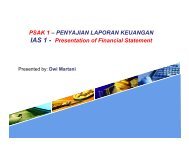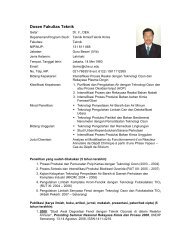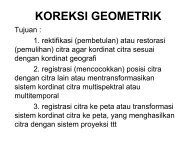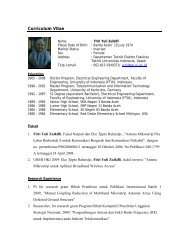PATOFISIOLOGI OBSTRUKSI URETER UNILATERAL DAN ...
PATOFISIOLOGI OBSTRUKSI URETER UNILATERAL DAN ...
PATOFISIOLOGI OBSTRUKSI URETER UNILATERAL DAN ...
You also want an ePaper? Increase the reach of your titles
YUMPU automatically turns print PDFs into web optimized ePapers that Google loves.
Obstructive Uropathy<br />
PATHOPHYSIOLOGIC CHANGES<br />
UUO vs BUO<br />
Arry Rodjani<br />
Urology Department<br />
Ciptomangunkusumo Hospital<br />
Jakarta
INTRODUCTION<br />
Obstructive uropathy refers to the functional or<br />
anatomic obstruction of urinary flow at any level of the<br />
urinary tract<br />
Obstructive nephropathy is present when the<br />
obstruction causes functional or anatomic renal damage<br />
Hydronephrosis is the dilation of the renal pelvis or<br />
calyces. It may be associated with obstruction but may<br />
be present in the absence of obstruction<br />
2
INTRODUCTION<br />
Urinary Tract Obstruction tubular pressure changes,<br />
renal blood flow, and glomerular filtration rate affecting the<br />
excretion function and renal homeostasis irreversible renal<br />
impaired<br />
3
INCIDENS<br />
Obstruction of the urinary tract may occur during<br />
fetal development, childhood, or adulthood<br />
In Indonesia mostly caused by stone in<br />
the urinary tract<br />
4
Posible causes of obstructive nephropathy<br />
Renal<br />
Congenital Polycystic kidney, renal cyst,<br />
aberrant vessel at ureteropelvic<br />
junction<br />
Neoplastic Wilms’ tumor, renal cell ca, TCC of<br />
the renal pelvis, multiple myeloma<br />
Inflamatory Tuberculosis<br />
Metabolic Calculi<br />
Miscellaneous Sloughed papillae, trauma, renal<br />
artery aneurism<br />
5
Posible causes of obstructive nephropathy<br />
Ureter<br />
Congenital Stricture, ureterocele, ureterovesical<br />
reflux, ectopic kidney, retrocaval<br />
ureter, Prune-Belly syndrome<br />
Neoplastic Primary carcinoma of ureter,<br />
metastatic carcinoma<br />
Inflamatory Tuberculosis, abscess, ureteritis<br />
cystica, endometriosis<br />
Miscellaneous Retroperitoneal fibrosis, pelvic<br />
lipomatosis, radiation therapy,<br />
lymphocele, trauma, urinoma,<br />
pregnancy<br />
6
Posible causes of obstructive nephropathy<br />
Bladder and Urethra<br />
Congenital Posterior urethral valve, phimosis,<br />
urethral stricture<br />
Neoplastic Bladder ca, prostate ca, ca of<br />
urethra, ca of penis<br />
Inflamatory Prostatitis, paraurethral abscess<br />
Miscellaneous Benign prostatic hyperplasia<br />
Neurogenic bladder<br />
7
SYMPTOMS<br />
Wide range symptoms, depend on:<br />
1. Acute / chronic<br />
2. Unilateral / bilateral<br />
3. The cause of obstruction (extrinsic vs intrinsic)<br />
4. Complete obstruction / parsial obstruction<br />
5. Presence or absence of infection<br />
6. Compliance of collecting system<br />
8
Pathophysiologic changes<br />
UUO vs BUO<br />
9
<strong>UNILATERAL</strong> <strong>URETER</strong>AL OBSTRUCTION (UUO)<br />
1.Acute phase (1-2 hrs)<br />
2.Mid phase (2-5 hrs)<br />
3.Later phase (5-24 hrs)<br />
11
Triphasic relationship between ipsilateral renal blood flow<br />
and left ureteral pressure during 18 hours of left-sided<br />
occlusion<br />
Pais V, In Walsh PC, Campbell’s Urology, WB Saunders 2007;37:1195-1126<br />
12
Summary of the functional changes<br />
during and following ureteral obstruction<br />
Pais V, Pathophisiology of Urinary Tract Obstruction In Walsh PC, Campbell’s Urology, WB Saunders 2007;37:1195-1126<br />
13
BILATERAL <strong>URETER</strong>AL OBSTRUCTION (BUO)<br />
This difference between the two pathophysiologic conditions <br />
due to an accumulation of vasoactive substances in BUO that<br />
could contribute to preglomerular vasodilation and<br />
postglomerular vasoconstriction.<br />
Such substances would not accumulate in UUO as they would be<br />
excreted by the contralateral kidney<br />
It is proved ==> diuresis and natriuresis after release of<br />
obstruction<br />
14
Summary of the functional changes<br />
during and following ureteral obstruction<br />
Pais V, Pathophisiology of Urinary Tract Obstruction In Walsh PC, Campbell’s Urology, WB Saunders 2007;37:1195-1126<br />
15
Summary of the functional changes during and<br />
following ureteral obstruction<br />
Unilateral Bilateral or Solitary Kidney<br />
16<br />
Pais V, In Walsh PC, Campbell’s Urology, WB Saunders 2007;37:1195-1126
Summary of the functional changes during and<br />
following ureteral obstruction<br />
Unilateral Bilateral or Solitary Kidney<br />
17<br />
Pais V, In Walsh PC, Campbell’s Urology, WB Saunders 2007;37:1195-1126
Summary of the functional changes during and<br />
following ureteral obstruction<br />
Unilateral Bilateral or Solitary Kidney<br />
18<br />
Pais V, In Walsh PC, Campbell’s Urology, WB Saunders 2007;37:1195-1126
RENAL FUNCTIONAL CHANGES AFTER<br />
RELEASE OF OBSTRUCTION<br />
Tubular renal function changes after the release of obstruction <br />
depends on whether the obstruction is unilateral or bilateral<br />
After elimination of complete bilateral obstruction natriuresis<br />
and diuresis post-obstructed diuresis<br />
19
RENAL FUNCTIONAL CHANGES AFTER<br />
RELEASE OF OBSTRUCTION<br />
GFR became normal after 1 week obstruction<br />
released.<br />
Not all nephrons are functionally reversible <br />
hyperfiltration occur in normal nephrons as a<br />
compensatory mechanism GFR back to normal level<br />
20
Summary of major pathways leading to tubulointerstitial fibrosis and tubular<br />
apoptosis as a consequence of ureteral obstruction<br />
Pais V, In Walsh PC, Campbell’s Urology, WB Saunders 2007;37:1195-1126<br />
21
DIAGNOSIS<br />
23
MANAGEMENT<br />
The management is performed to :<br />
(a) relief pain<br />
(b) recover or maintain renal function<br />
(c) avoid complication<br />
24
Indication to release obstruction<br />
Unilateral obstruction Bilateral obstruction<br />
Pain unrelieved by<br />
analgesics<br />
Signs and symptoms of<br />
sepsis<br />
Persistent nausea and<br />
vomiting<br />
Same as for OUU or<br />
Elevated BUN and creatinine<br />
Signs and symptoms of<br />
uremia<br />
High-grade obstruction Hyperkalemia<br />
25
Aim of study<br />
Wheather improvement of kidney function<br />
after drainage of the obstructed kidney are<br />
depend on parenchymal thickness and<br />
hemoglobin level<br />
27
Methods<br />
• Prospective study<br />
• 124 patients with bilateral (or unilat in solitary<br />
kidney) obstructive uropathy underwent<br />
percutaneous nephrostomy<br />
• BUN, serum creatinin and Hb measured<br />
28
Methods<br />
• Kidney perenchym thickness measured by<br />
Pie Medical scanner 200 ultrasound<br />
• Patients were stratified into Hb
Results n = 124 pts<br />
Creatinine (mg/dl) at H 14:<br />
Hb 1 2.8 ± 1.1<br />
Hb 2 1.8 ± 1.1 (p < 0.01)<br />
K 1 2.7 ± 1.0<br />
K 2 1.7 ± 0.6 (p < 0.01)<br />
30
Conclusion<br />
Haemoglobin level and renal parenchymal<br />
thickness are good prognostic factors for<br />
renal function recovery after percutaneous<br />
nephrostomy in obstructive uropathy<br />
patients<br />
31
SUMMARY<br />
1. Urinary tract obstruction tubular pressure<br />
changes, renal blood flow, and glomerular filtration<br />
rate affecting the excretion function and renal<br />
homeostasis irreversible renal impaired<br />
1. Several substances are thought to play a role in<br />
the apoptosis tubulular fibrosis and atrophy ==><br />
tubulointerstitial fibrosis ==> The mechanism of<br />
the development of CRF<br />
32
SUMMARY<br />
3. There are several differences between BUO and<br />
UUO ==> hemodynamic changes and some factors<br />
that might affect GFR<br />
4. A number of vasoactive substances are thought to<br />
play a role in the changes in RBF and GFR<br />
occurring with both models of obstruction.<br />
33
Thank You<br />
34



